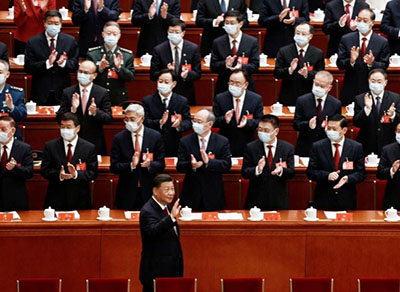Special to WorldTribune.com
In the grand political choreography that defines China, the recently concluded 20th Chinese Communist Party Congress in Beijing presented a spectacular show but with a very predictable conclusion.
Set in Beijing’s huge Great Hall of the People, the trappings, the ritual and the rites of the People’s Republic unfolded to the backdrop of massive crimson and gold banners and thunderous martial music. Xi Jinping was given an unprecedented third term as leader and thus seamlessly was transformed into China’s new emperor.
Not since the days of the late dictator Mao Tsetung has any single communist ruler amassed so much personal power.
Xi remains chief of the ruling Chinese Communist Party (CCP), the president and chief of state of the People’s Republic, and chairman of the Central Military Commission controlling the armed forces.

But there’s also the ideological vibe of a new era.
In short, the Supreme Leader Xi controls the world’s largest and most lethal dictatorship.
Let’s briefly discuss the transition.
At the Great Hall of the People, just off Tiananmen Square, the CCP staged its week-long congress with 2,300 delegates. Two hundred were picked to join the Central Committee, and 25 were chosen to the powerful party Politburo. The elite seven member Standing Committee was then selected.
Not surprisingly, Chairman Xi shuffled the political house of cards; Long-serving Premier Li Keqiang was out. Xi’s predecessor Hu Jintao, was humiliatingly ushered out of the lineup, literally from his seat next to Xi.
The Chairman is playing by old school Maoist rules. During Xi’s decade in power, China has seen a tightening of social and political controls. Economically, the PRC largely still allowed the successful state capitalism model mixed with the old Iron Rice Bowl socialist dominated by heavy and heavily polluting industries. Now, “Xi Jinping thought” becomes the ideological mantra of Chinese socialism, a high octane nationalist philosophy which remains skeptical of private business and seeks to strengthen the security State.
Alarmingly, the PRC is drifting from its authoritarian system and tracking towards an totalitarian state as during Mao’s era. But contrary to the 1960’s and 1970’s, modern China has experienced social and economic changes unimaginable decades ago. Yet rigid CCP political control exists in tandem with what is largely an authoritarian regime.
Internationally, China maintains close political links with regimes ranging from North Korea to Burma. More significantly, Beijing has close ties with the Islamic Republic of Iran and naturally Russia. China’s diplomatic support in the UN Security Council extends to both rogue regimes as well as developing states in Africa and Asia.
But the real geopolitical challenge for the USA and Japan lies on the horizon in East Asia. To quote the old Maoist anthem, The East is Red and it’s in the East where the sun rises over Taiwan, the democratic self-ruled island which the Beijing regime claims and may try to conquer.
Xi’s speech at the 20th Party Congress bluntly restated his diktat towards democratic Taiwan; “We insist on striving for the prospect of peaceful reunification …but we will never promise to give up the use of force and reserve the option to take all necessary measures.”
Chairman Xi warned, “The historical wheels of national reunification and national rejuvenation are rolling forward and complete reunification of the motherland must be achieved,” he stated to thunderous applause.
Taipei’s government retorted that Taiwan will not surrender its sovereignty nor compromise on freedom and democracy; The island’s people solidly oppose the PRC’s “one Country, two Systems,” formula under which Beijing rules Hong Kong.
Since 1949 and the end of the Chinese civil war when Mao’s communist seized the Mainland, the Republic of China on Taiwan has been separately ruled as a self-governing democracy which has never been controlled by the PRC communists for a single day.
Though a status quo across the Taiwan Straits has largely held during which Taiwan has been able to transform itself into a prosperous economy and multi-party democracy despite longtime PRC threats, the military balance is clearly shifting in communist China’s favor.
Significantly, though Taiwan doesn’t have a defense treaty with the USA as does South Korea or Japan, Washington has favored a policy of strategic ambiguity through which Beijing cannot be certain of an American response to defend the New Hampshire sized island. The Biden Administration has sent dangerously mixed signals as to what an American response would be to Chinese aggression.
A decade ago, Chairman Xi’s rule began with the slogan extolling the “Chinese Dream.” Shall East Asia now awaken to a geopolitical nightmare?
John J. Metzler is a United Nations correspondent covering diplomatic and defense issues. He is the author of Divided Dynamism the Diplomacy of Separated Nations: Germany, Korea, China (2014). [See pre-2011 Archives]

 By
By